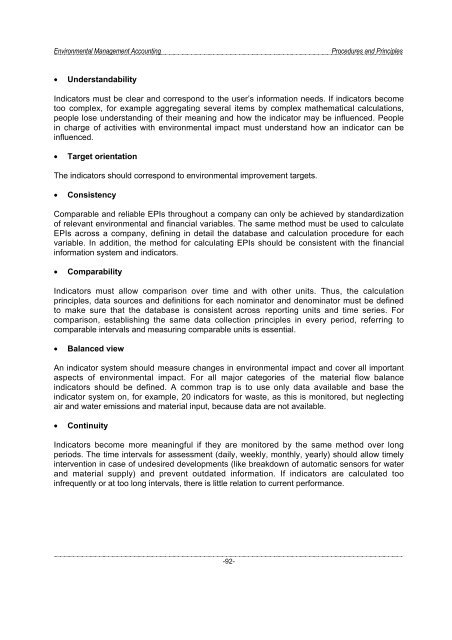Environmental Management Accounting Procedures and Principles
Environmental Management Accounting Procedures and Principles
Environmental Management Accounting Procedures and Principles
You also want an ePaper? Increase the reach of your titles
YUMPU automatically turns print PDFs into web optimized ePapers that Google loves.
<strong>Environmental</strong> <strong>Management</strong> <strong>Accounting</strong><br />
<strong>Procedures</strong> <strong>and</strong> <strong>Principles</strong><br />
• Underst<strong>and</strong>ability<br />
Indicators must be clear <strong>and</strong> correspond to the user’s information needs. If indicators become<br />
too complex, for example aggregating several items by complex mathematical calculations,<br />
people lose underst<strong>and</strong>ing of their meaning <strong>and</strong> how the indicator may be influenced. People<br />
in charge of activities with environmental impact must underst<strong>and</strong> how an indicator can be<br />
influenced.<br />
• Target orientation<br />
The indicators should correspond to environmental improvement targets.<br />
• Consistency<br />
Comparable <strong>and</strong> reliable EPIs throughout a company can only be achieved by st<strong>and</strong>ardization<br />
of relevant environmental <strong>and</strong> financial variables. The same method must be used to calculate<br />
EPIs across a company, defining in detail the database <strong>and</strong> calculation procedure for each<br />
variable. In addition, the method for calculating EPIs should be consistent with the financial<br />
information system <strong>and</strong> indicators.<br />
• Comparability<br />
Indicators must allow comparison over time <strong>and</strong> with other units. Thus, the calculation<br />
principles, data sources <strong>and</strong> definitions for each nominator <strong>and</strong> denominator must be defined<br />
to make sure that the database is consistent across reporting units <strong>and</strong> time series. For<br />
comparison, establishing the same data collection principles in every period, referring to<br />
comparable intervals <strong>and</strong> measuring comparable units is essential.<br />
• Balanced view<br />
An indicator system should measure changes in environmental impact <strong>and</strong> cover all important<br />
aspects of environmental impact. For all major categories of the material flow balance<br />
indicators should be defined. A common trap is to use only data available <strong>and</strong> base the<br />
indicator system on, for example, 20 indicators for waste, as this is monitored, but neglecting<br />
air <strong>and</strong> water emissions <strong>and</strong> material input, because data are not available.<br />
• Continuity<br />
Indicators become more meaningful if they are monitored by the same method over long<br />
periods. The time intervals for assessment (daily, weekly, monthly, yearly) should allow timely<br />
intervention in case of undesired developments (like breakdown of automatic sensors for water<br />
<strong>and</strong> material supply) <strong>and</strong> prevent outdated information. If indicators are calculated too<br />
infrequently or at too long intervals, there is little relation to current performance.<br />
-92-




